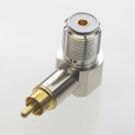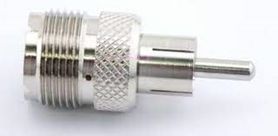RCA Connectors Are New Again

[April 2023] Earlier in the year, Clay talked about the range of solderless connectors now available. This time, he goes deeper into the “Phono Connector,” discussing what is available, but also delving into the history of the connector.
Simply finding ways to avoid using a soldering iron is good, but knowing more about the tools you use each day is not only interesting, but makes you aware of the “why” they were created.
Last time, I explored some of the newer, solderless, audio and DC power connectors. This time, let us take a look at the, still very much in use, RCA or “Phono Connector.”
First a look at what is new.
SOMETHING NEW
For instance, could you use a female RCA connector in your work?
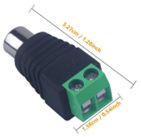
You can now, and they are not expensive – just look at these Amazon prices
Starting at less than a dollar, you can put them right to work.
And they work like this –
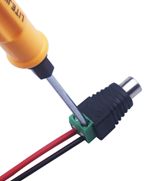
(Yes, this appears to be a Phillips Head Screw and not a Green Colored driver.
Of course, as I showed you last time, they come in male versions:
And, again, while a bit more than the female version, they are reasonably priced too.
HOW ABOUT A LITTLE HISTORY?
With that in mind, have you ever wondered about the RCA Connectors history?
Look at this one from waaaay back.
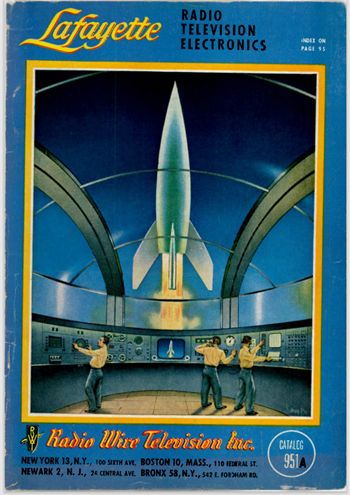
Lafayetter catalog circe 1951
Inside this publication was more information about the original RCA connector, then simply called a Phono Tip Plug.
Old timers (Like me) Encountered a lot of these over the years. Yes, they required soldering skills. And the only time a screwdriver was required was to mount the connector to something else.
DIGGING A BIT DEEPER
The basic definition of an RCA connector is that it is a type of electrical connector commonly used to carry audio and video signals.
As you would imagine, the name RCA derives from the company Radio Corporation of America, which introduced the design in the 1930s. Hence, the connectors male plug and female jack are called RCA plug and RCA jack.
They are also called an RCA phono connector or phono connector – the word phono in phono connector is an abbreviation of the word phonograph, because this connector actually was originally created to allow the connection of a phonograph turntable to a radio receiver.
Today, RCA jacks are often used in phono inputs, a set of input jacks usually located on the rear panel of a preamp, mixer or amplifier, especially on early radio sets, to which a phonograph or turntable is attached.
FROM THE 1930s
By no later than 1937, RCA introduced this design as an internal connector in their radio-phonograph floor consoles.
The amplifier chassis had female connectors which accepted male cables from the radio chassis and phonograph player Originally, the concept was intended as an easy method to unhook sources while troubleshooting the console during servicing.
By no later than 1938, RCA migrated the female connector to the rear panel of many of their desktop AM radio models to allow customers an easy method to attach an external phonograph or television at a later date. The connector was labelled on the back of radio with one of the following terms: “Victrola”, “Phono”, “Pick-up”, or “Television.” RCA later marketed a special turntable for 45 RPM records, the model 9JY.
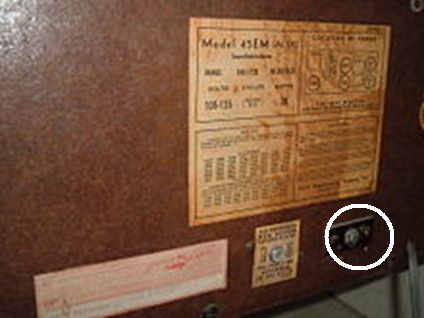
The rear panel of a 1939 RCA model 45EM vacuum tube
desktop AM radio with a female RCA jack. The tag reads
“An inexpensive RCA Victor record player will make a fine
Victrola of this radio. Plug here.”
In 1939, RCA introduced two radio-television floor consoles (TRK-9, TRK-12) which used the same internal connection concept but the audio output of the television chassis was connected to the radio/amplifier chassis via a male to male cable. Three lower-cost 1939 television models had an audio output connector on their rear panel instead of an integrated amplifier and speaker: RCA TT-5, Westinghouse WRT-700, GE HM-171.
MORE AND MORE IN USE
In the 1950s, RCA connectors began to replace the older quarter-inch (1⁄4 inch) phone connectors for many other applications in the consumer audio world when component high-fidelity systems started becoming popular during the transistor revolution.
Refinement of the RCA connectors came with later designs, although they remained compatible. Obviously, the RCA connector went on to become the standard connector for just about every Hi-Fi and Stereo piece of equipment out there.
Some RCA Connectors have become quite advanced compared to their humble beginnings in the 1930’s.
SOLID DESIGN
In the most normal use, cables have a standard plug on each end, consisting of a central male connector, surrounded by a ring.
The male plug has a center pin which is 3.175 mm (1/8 inch) in diameter, and is surrounded by an outer shell which is 8.25 mm (1/3 inch) in diameter.
The ring on the jack is often segmented to provide spring gripping pressure when mated. Devices mount the socket (female jack), consisting of a central hole with a ring of metal around it. The ring on the jack is slightly smaller in diameter and longer than the ring on the plug, allowing the plug’s ring to fit tightly over it. The jack has a small area between the outer and inner rings which is filled with an insulator, typically plastic (very early versions, or those made for use as RF connectors, used ceramic).
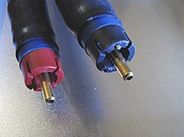
RCA Plug with segmented rings
The hot signal wire and signal ground provided by an RCA connect implement an unbalanced connection. When connecting the male into the female, the inner hot (signal) connection is made before the ground connection has been guaranteed; this often produces a loud buzz if the equipment is active when the connection is made.
A true balanced connection is generally preferred in certain applications, particularly professional settings because it allows for the use of long cables while reducing susceptibility to external noise.
Of course, using RCA connectors, each signal requires its own plug. Even the simple case of attaching a cassette deck may need four of them – two for stereo input and two for stereo output. In any common setup this quickly leads to a disarray of cables and confusion in how to connect them. This situation is made worse if one considers more complex signals like component video (a total of three for video and two for analog audio or one for digital coaxial audio).
POWER, RF, AND VIDEO, TOO
As we noted, the RCA connector was initially used for audio signals.
As Television sets became more compatible with other home entertainment equipment with the advent of VCR’s etc. The RCA connector became the connector of choice for not only audio but video. (It would be light-years before we would see a VGA or HDMI Connector)
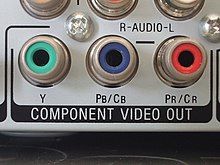
Audio or Video
the RCA plug does it all
As with many other connectors, it has been adopted for uses other than originally intended, including as a DC power connector, an RF connector, and as a connector for loudspeaker cables. Its use as a connector for composite video signals is extremely common, but provides poor impedance matching.
STILL POPULAR
There have been attempts to introduce combined audio/video connectors for direct signals, but in the analog realm none of these has ever become common, with the exception of Europe where the SCART connector was very successful.
For a time, the 5-pin DIN connector was popular for bi-directional stereo connection between A/V equipment, but it has been entirely displaced on modern consumer devices. Though RF modulators inherently transmit combined A/V signals in video applications, they depend on broadcast television systems and RF connectors which are not universal worldwide; RF signals are also generally inferior to direct signals due to protocol conversion and the RF limitations of the three major analog TV systems (NTSC, PAL and SECAM).
Before HD television became a standard, nearly all TV sets, VCRs, and DVD players sold in Europe had SCART connectors, although these are sometimes supplemented by RCA and/or RF connectors. SCART-RCA adapters also exist, which usually allow input of composite video and stereo audio. Outside Europe, separate RCA connectors are usually used, supplemented by RF connectors for backward compatibility and simplicity. Although mini-DIN connectors are used for S-Video connections, composite video, component video, and analog audio (mono or stereo) all use RCA connectors unless the signals are sent via SCART.
In the digital realm, however, combined A/V connectors are gaining ground; HDMI is commonly used today for consumer electronics, and DisplayPort, a potential competitor to HDMI, is often found on home computers and peripherals.
COLOR CODED
Plugs and sockets on consumer equipment are conventionally color-coded to aid correct connections.
RCA jacks are often colo-coded, yellow for composite video, red for the right audio channel, and white or black for the left channel of stereo audio.
This trio (or pair) of jacks can often be found on the back of audio and video equipment. One or more sets are often found on TV sets to facilitate connection of camcorders, other portable video sources and video game consoles.
RCA connectors and cable are also commonly used to carry S/PDIF-formatted digital audio, with plugs colored orange to differentiate them from other typical connections.
Although nearly all connectors, including analog and S/PDIF audio as well as composite and component video, can use identical 75 Ω cables, sales of special-purpose cables for each use have proliferated. Varying cable quality means that a cheap line-level audio cable might not successfully transfer component video. For digital audio, as long as a connection is successfully made using the cables the sound will remain faithful to the original signal because a digital signal can only be fully received or not received at all. Cables should meet the S/PDIF specification as defined by the international standard IEC 60958-3 for assured performance.
COLOR CODING IN CONSUMER EQUIPMENT
The standard colors for the various signals are shown below; however, beyond 7.1 audio, the standard has degraded to a more general white/yellow, red/blue, and green/yellow color scheme for each cable respectively.
Stereo audio applications use either black and red, grey and red, or white and red RCA connectors; in all three cases, red denotes right. White or purple may also be replaced by black.
Some older tape recorders, and equipment like receivers designed to connect to them, use a 5-pin DIN connector to connect left and right for record and playback with a single cable. Adapters between this connector and RCA connectors have used white and red for left and right channel recording, and blue (or sometimes black) and yellow for playback, but this is not universal. Most modern equipment with RCA connectors for recording devices simply uses white and red for all stereo pairs, whether record or playback.
While these are the standard colors found on commercially made products, cables with different-colored connectors may be used, as long as the cable itself is compatible with the application (for example, cables with 75 ohms impedance for video and S/PDIF).
The following is a handy chart that shows how the various colors are used. If you work in the home-entertainment-equipment business, you may have this memorized. If you are like me, some of this is new. I hope you find it useful as you deal with this historic connector.
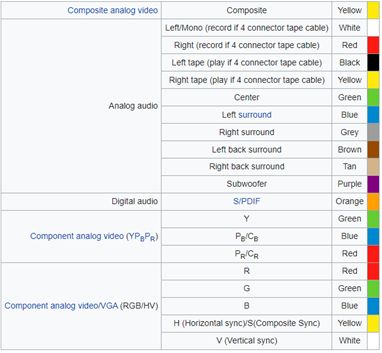
Before I close on the humble RCA connector, I do recall it being used for an RF connector in Ham radio equipment. To underscore this thought, look at some of the “RF Adaptors” available for the RCA Connector:
RCA to UHF Female
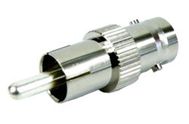
RCA to BNC
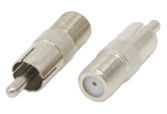
RCA to F
Yes, the RCA connectors have been workhorses for nearly 100 years, and are still going strong. and p,
– – –
Clay Freinwald, a frequent contributor to The BDR, is a veteran Seattle market engineer who continues to serve clients from standalone stations to multi-station sites. You can contact him at k7cr@blarg.net
– – –
– – –


